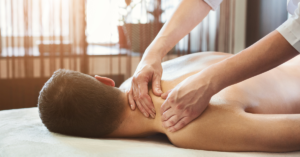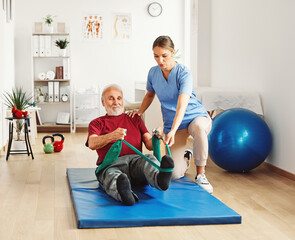Several studies have shown that massage reduces anxiety and improves mood. One theory is that massage stimulates brain circuitry associated with positive emotions and reduces the levels of the stress hormone cortisol while increasing serotonin.
If you get a good massage, you may feel elated or “on cloud nine.” This is completely normal and is due to the relaxation response. For more information visit Carlsbad Massage Reset.

Massage is a form of touch therapy designed to increase relaxation in the body. It stimulates the parasympathetic nervous system, which helps to reduce heart rate and blood pressure while lowering stress hormone levels. It is also a great tool to help with depression and anxiety. It can even help with chronic pain. It increases the flow of oxygen and nutrients to cells, speeding up tissue repair and reducing swelling from injury. It also releases feel-good chemicals like serotonin to give you a natural high. The soothing environment created by massage, aromatherapy, and music can also increase relaxation.
During a massage, friction between the skin and fingers causes an increase in temperature that helps to relax muscles and soft tissues of the body. It can even relieve muscle tension in tense areas due to stress. This is because it can break up adhesions in the tissues. It may also reduce fibromyalgia and other chronic pain conditions by decreasing stiffness and improving mobility.
It is important to remember that not all types of massage are the same. You will want to find the right type of massage that works for your needs, and it will take some trial and error to figure out which type of massage is best for you. During a relaxation massage, the therapist will use gentle kneading and long, smooth stroking movements to release muscle tension while returning the body to a relaxed state.
One of the biggest benefits of massage is that it can lower stress and improve mood. It can help with feelings of anxiety and depression by boosting the production of neurotransmitters, such as endorphins, serotonin, and dopamine. These are all beneficial in relieving stress, preventing depression, and increasing motivation and self-esteem.
It can also help relieve stress by reducing cortisol, a stress hormone that can cause anxiety and depression. Studies have shown that after a massage, the cortisol level decreases, which can lower stress and boost the feeling of relaxation. This is because it is replaced with positive hormones, such as serotonin and dopamine, which promote physical and mental relaxation.
The squeezing action of massage, as well as the heat from the hands and the body, helps to circulate blood throughout the whole system. This can help to remove metabolic waste from muscles and reduce toxins. It also sends oxygen and nutrients to the tissues that need it. This can be especially helpful for those who suffer from Raynaud’s phenomenon (which causes painful cold fingers and toes) and those recovering from surgery or injury.
There is some evidence that massage improves circulation by stimulating the nerves that control the dilation and constriction of blood vessels. However, this does not directly translate into an increase in overall circulation. It may be a more accurate way to describe some of the effects of massage, such as improved vascular tone and increased flexibility of the blood vessel walls.
For example, massage may help to ease a condition called claudication that can occur in the legs when a muscle or group of muscles compresses blood vessels. This condition can be caused by chronically tight muscles around the knees or groin. Massage can relieve this problem by causing the squeezing muscle to relax and allow the blood vessels to expand.
This is one of the reasons that massage is often recommended for those suffering from fibromyalgia. Research has shown that massage can decrease pain and stiffness and improve sleep and energy. It also reduces anxiety and depression in those with fibromyalgia and enhances the immune system.
Another important benefit of massage is that it can help prevent clots in the veins, which can be caused by excess blood pressure. Studies have shown that massage can help to reduce the amount of clots and improve the mobility of the veins.
Many things can affect circulation, including exercise, diet, and hormones. A doctor should be consulted if you have a serious problem with poor circulation. Aside from that, there is no reason not to get a massage regularly to maintain good health and promote relaxation and well-being.
Pain is the number one reason people seek medical help, and massage is a non-invasive and natural way to reduce and manage pain. It’s also safe to use in conjunction with other therapies and treatments. Massage can also help relieve anxiety and promote healing of the body and mind.
Massage stimulates the nerves and muscles of the body to release positive hormones such as endorphins, serotonin, and dopamine, which are known to reduce stress and anxiety and increase relaxation, happiness, and motivation. Increasing the levels of these positive hormones can also decrease pain, tension, and stiffness.
The friction caused during a massage increases blood flow to the treatment area, which helps muscles relax by increasing tissue elasticity and reducing pain by lowering muscle tightness. It also improves the movement of joints by relieving stiffness and improving flexibility. This increased range of motion helps to decrease stress and reduces the amount of energy that is needed to perform daily activities.
Studies have shown that massage can decrease pain by interrupting the process of signal transmission from specialized sensory receptors in the body to the brain. These receptors are called nociceptors and are sensitive to thermal, mechanical, and chemical stimuli. The pain message from these nociceptors is sent along slow, thin nerve fibers to the spinal cord, where it can be blocked by stimulating competing nerve impulses with massage, such as touch and pressure.
During a massage, stimulating the small lymph vessels transporting fluid around the body to glands and nodes will also help reduce pain. Massage can stimulate the nodes and glands to secrete anti-inflammatory chemicals to decrease inflammation.
Another way that massage can reduce pain is through the gate control theory of pain. This theory states that pain messages are sent to the brain through a pathway of slow, thin nerves and can be blocked by introducing fast, large nerves in the area during massage. Massage can do this by stimulating the larger outer nerves via the cutaneous nerves (responsible for skin sensation), proprioceptors that report joint position, and mechanoreceptors that respond to pressure.
Studies show that a single massage reduces cortisol levels, a hormone produced during stress. This hormone increases glucose in the bloodstream, enhances brain use of glucose, and curbs nonessential functions in a fight-or-flight situation. By lowering the cortisol in your body, massage reduces stress, anxiety, and feelings of sadness. In addition, it increases the release of serotonin, a neurotransmitter that relieves depression and carries signals between nerves.
It’s been said that massage is the “ultimate hug.” The soothing touch of a masseuse can soothe tense muscles and help you relax. It can also relieve the tension that triggers headaches, such as migraines. In a clinical study, massage decreased pain intensity in 105 patients with migraines by stimulating muscle relaxation and decreasing the stress hormone cortisol. It also increased the number of hours a patient was able to sleep and reduced levels of substance P, which is known to grow in the presence of stress and triggers migraines.
A massage can also stimulate the autonomic nervous system, encouraging an increase in positive hormones. These include endorphins, serotonin, and dopamine. These are neurotransmitters that offer a variety of benefits. Endorphins help reduce anxiety, serotonin prevents depression and boosts a sense of well-being, and dopamine increases motivation and self-worth. In a way, a massage is like an hour-long hug.
Many people feel stressed due to work, family, or finances. However, there are many ways to alleviate stress, and your health needs to do so. Stress can cause heart disease, high blood pressure, and depression in some people. Stress can also affect the reproductive system and negatively impact sperm production in men, breast milk in women, and ovulation in both sexes. Massage can ease symptoms of stress and promote a healthier lifestyle.
